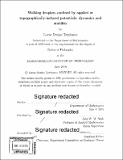| dc.contributor.advisor | John W. M. Bush. | en_US |
| dc.contributor.author | Tambasco, Lucas Dorigo | en_US |
| dc.contributor.other | Massachusetts Institute of Technology. Department of Mathematics. | en_US |
| dc.date.accessioned | 2018-09-17T15:47:28Z | |
| dc.date.available | 2018-09-17T15:47:28Z | |
| dc.date.copyright | 2018 | en_US |
| dc.date.issued | 2018 | en_US |
| dc.identifier.uri | http://hdl.handle.net/1721.1/117860 | |
| dc.description | Thesis: Ph. D., Massachusetts Institute of Technology, Department of Mathematics, 2018. | en_US |
| dc.description | Cataloged from PDF version of thesis. | en_US |
| dc.description | Includes bibliographical references (pages 121-129). | en_US |
| dc.description.abstract | In 2005, Yves Couder and coworkers discovered that a millimetric droplet of silicone oil may walk on the surface of a vertically-vibrating fluid bath, displaying features that were once thought to be peculiar to quantum mechanics. We here explore this hydrodynamic pilot-wave system through an integrated theoretical and experimental approach. We provide a theoretical characterization of the transition to chaos in orbital pilot-wave dynamics for droplets walking in the presence of a Coulomb, Coriolis, or central harmonic force. We proceed by investigating this hydrodynamic system above the Faraday threshold experimentally, with an aim of finding mechanisms to trap drops. We report a hydrodynamic analog of optical trapping with the Talbot effect, showing that drops may become trapped at the extrema of waves generated in the vicinity of a linear array of pillars. We also characterize the dynamics of droplets bouncing and walking above the Faraday threshold, indicating regimes of particle trapping and Brownian motion. We investigate the effect of bath topography in drop dynamics by considering a circular well that induces a circularly-symmetric Faraday wave pattern. In this regime, we show that droplets become trapped into stable circular orbits around the extrema of the well-induced wavefield. Finally, with a view to extending the phenomenological range of this hydrodynamic system, we consider a generalized pilot-wave framework, in which the relative magnitudes of dynamical parameters are altered relative to those relevant in the fluid system. In this generalized framework, we validate the theoretical result of Durey et al. relating the particle's mean wavefield to the emerging statistics, and characterizing the timescale of emergence of the statistically steady state for the chaotic pilot-wave dynamics. | en_US |
| dc.description.statementofresponsibility | by Lucas Dorigo Tambasco. | en_US |
| dc.format.extent | 129 pages | en_US |
| dc.language.iso | eng | en_US |
| dc.publisher | Massachusetts Institute of Technology | en_US |
| dc.rights | MIT theses are protected by copyright. They may be viewed, downloaded, or printed from this source but further reproduction or distribution in any format is prohibited without written permission. | en_US |
| dc.rights.uri | http://dspace.mit.edu/handle/1721.1/7582 | en_US |
| dc.subject | Mathematics. | en_US |
| dc.title | Walking droplets confined by applied or topographically-induced potentials : dynamics and stability | en_US |
| dc.type | Thesis | en_US |
| dc.description.degree | Ph. D. | en_US |
| dc.contributor.department | Massachusetts Institute of Technology. Department of Mathematics | |
| dc.identifier.oclc | 1051182780 | en_US |
